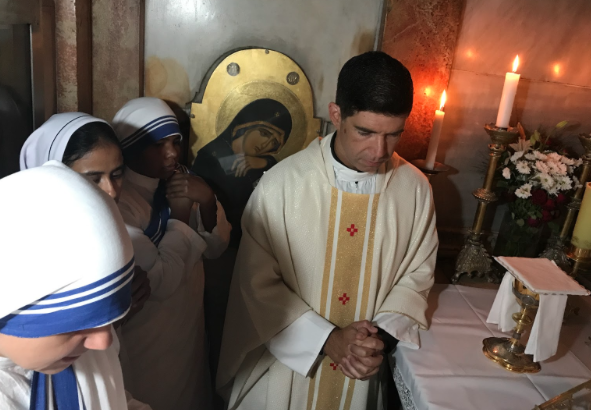Sacred summer trips
Campus priests retrace Jesus’ steps

Photo by Father Richard Castro
Father Patrick Wainwright journeyed to many sacred places that were important to Jesus, one being the Tomb of Christ in Jerusalem, where he participated in Mass where Jesus was buried and rose from the dead.
While many Cathedral Catholic High School students dedicated their summer vacations to leisure activities, Father Patrick Wainwright devoted his summer to spiritual renewal by visiting the Tomb of Christ, where he deepened his faith and celebrated Mass.
“[Growing our faith] helps [us] to understand that God wants to be close to us,” Father Wainwright said. “We sometimes feel like God is so far away. In reality, God is so close to us that he wanted to live among us.”
Father Wainwright’s holy experience was part of a series of christian pilgrimages Father Wainwright and Father Richard Castro embarked on to enhance their faith journeys during summer.
Father Wainwright walked along the path of Via Dolorosa, where Christ carried his cross from the Palace of Pilate to Mount Calvary. Father Wainwright also traveled to the prison where Jesus is said to have stayed the night before his sentencing.
Father Castro began his journey this summer in Argentina from June 12 to July 3. Then, he ,traveled to Mexico City where he celebrated Mass at Our Lady of Guadalupe.
“The opportunity [to complete pilgrimages] was very joyful and faith filled,” Father Castro said. “Due to Our Lady of Guadalupe’s dedication to the Blessed Virgin Mary, I felt that seeing this church and attending Mass in the Basilica made my devotion to Our Lady much stronger.”
Father Wainwright echoed these sentiments.
“My faith did not change in any way, but it did become more certain once I was in the presence of these sacred places,” Father Wainwright said. “I was able to journey along the same places that Jesus had traveled. These buildings tell us a history, a real story, a real fact, that God became man.
“He was here in order to bring me salvation.”
For only 60 hours in October, researchers examined the spot where Jesus was laid to rest. Ms. Jodi Magness, archaeologist and National Geographic grantee, discussed the tomb and its prominence.
“We don’t have any churches before the time of Constantine because Christianity was an illegal religion in the Roman Empire,” Ms. Magness said in a recent telephone interview. “Therefore, Christians were persecuted and could not worship openly. So, at least since the time of Constantine, this has been venerated by Christians as the tomb in which Jesus’ body was laid.”
Through their research, archaeologists dug deeper into the timeline of Jesus’ life.
“In terms of Christian tradition, [the findings] go back as far as one can go,” Ms. Magness said. “This still leaves a 300-year gap between the time of Jesus and Constantine. So, one would have to assume that Jesus’ followers and local Christian community preserved that memory for the intervening 300 years, which is why I say accepting the tomb as the tomb of Jesus is a matter of faith, not science.”
Researchers have not given complete certainty about the Tomb of Christ.
“What I always tell people is that archaeology cannot verify that Jesus’ body was laid in this tomb [as] that is a matter of faith,” Ms. Magness said. “However, many scholars consider the tomb to be authentic because this tradition goes back to the time of Constantine, who was the first Roman emperor to legalize Christianity [in the early 4th century].”
Father Wainwright and Father Richard remain thankful for the chance to journey throughout the sacred places, feeling their journeys will ultimately benefit their ministries.
“I already believed that Jesus was there, but when you see it, it becomes more difficult to deny,” Father Wainwright said.

During my sophomore year at Cathedral Catholic High School this year, I look forward to writing for El Cid as the Photo Editor and experiencing the writing...




















































